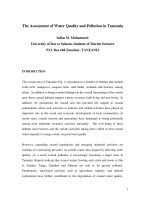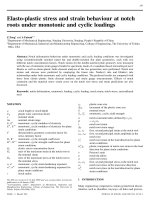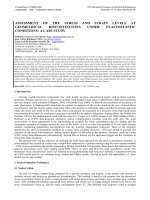assessment of the stress and strain levels at geometrical discontinuities under elastoplastic conditions a case study
Bạn đang xem bản rút gọn của tài liệu. Xem và tải ngay bản đầy đủ của tài liệu tại đây (623.76 KB, 9 trang )
ASSESSMENT OF THE STRESS AND STRAIN LEVELS AT
GEOMETRICAL DISCONTINUITIES UNDER ELASTOPLASTIC
CONDITIONS: A CASE STUDY
Eduardo César Gavazza Menin, Eng.,
José Carlos Balthazar, PhD.,
Jorge Luiz de Almeida Ferreira, Dr.,
Department of Mechanical Engineering
University of Brasília - UnB
Campus Universitario Darcy Ribeiro, Asa Norte
70910-900 Brasília – DF BRAZIL
Abstract. Consideration of structural failures caused by initiation and growth of cracks at stress concentration points are extremely
important for safe design of structural component which will avoid accidents that may cause life and financial losses. At notch roots
if the stress level exceed the yield stress the strain will become the dominant factor to control the cracking initiation process and an
elastoplastic analysis will be necessary in order to determine the actual stress and strain values. In the present work the finite
element analysis and the models proposed by Neuber(1961) and Glinka(1985) were used to assess the validity of the local strain
approach in the estimation of the stress and strain levels on a plate with a central hole subjected to uniform axial loading. Specimens
made of Al alloy 7050 T7451 and MAN-TEN steel were used to study possible effects of stress-strain curve behaviour on the stress
distribution. The theoretical stress concentration factor of the hole was determined using photoelastic and numerical methods. The
applicability of the models proposed by Neuber and Glinka was assessed comparing the results obtained with both methods and the
results from the finite element analysis. The results show that Neuber and Glinka models may underestimate the stress values for
plane stress while may overestimate the strain levels depending on the model adopted and state of stress.
Keywords. Stress concentration, notches, elastoplastic analysis, Neuber’s rule, Glinka’s rule.
1. Introduction
Intensily loaded structural components may yield locally at stress concentration points such as holes, notches,
geometric changes, keyways etc. Under cyclic loading, local plasticity may induce redistribution of the stress gradients
and also fatigue crack initiation (Fillippini, 2000, Visvanatha et al, 2000). To identify the possibility of occurrence of
such phenomena is fundamentally important to conduct an analysis of the cyclic strain at the root of those stress
concentrators. Due the need to reduce computing effort such analysis is commonly done using the local strain approach
where the stress and strain at the root of the stress concentrator are estimated as a function of the theoretical stress
concentration factor and of a constitutive equation to account for the material behaviour. Among others, the Neuber rule
(Neuber, 1961) is the method mostly used with this objective. Topper et al (1969), Seeger et al (1980), Glinka (1985) e
Hoffman et al (1985) also proposed alternative and/or complementary methods with the same aim. The great
inconvenient of those approaches is the impossibility to evaluate the stress redistribution due to yielding and the
consequent geometrical changes around the root of the notch. A way to solve this problem is to use finite element
method considering geometrical non-linearities and the material elastoplastic behaviour. Most of the literature
approaches the stress concentration problem as a plane stress problem (Peterson, 1974) not taking in account any
variation of the stress with thickness, adding another degree of difficulty to the problem. Research made by Cunha
(1981) using three-dimensional photoelasticity showed that as thicker are the specimens bigger are the variations in
stress state along thickness.
The present work had the objective of verifying the local strain approach for the stress concentration problem. A
stress analysis was carried on a plate with a central hole subjected to a uniform loading using the finite element method
– FEM an also considering the models proposed by Neuber and Glinka. The possible effects due to the behaviour of the
material stress/strain curve were studied using 7050 T7451 Al alloy and Man-Ten steel constitutive curves. The
theoretical stress concentration factor was determined using photoelastic and numerical methods. Comparison between
the FEM results and the one obtained using Neuber and Glinka models allowed to verify the applicability of these
models for the case studied.
2. Strain Estimation Techniques
2.1 Neuber’s Rule
The rule of Neuber, despite being proposed for a specific geometry and loading, is the mostly used method to
describe stresses and strains on geometrical discontinuities. This method is based in the premiss that the theoretical
stress concentration factor K
t
used to relate nominal with actual local stresses and strains stays constant up to yielding
starts. After yielding the nominal and actual local stresses and strains are no longer linearly related by K
t
but by the
stress concentration factor K
σ
and the strain concentration factor K
ε
. The different local response is due to residual
Proceedings of COBEM 2003 17th International Congress of Mechanical Engineering
COBEM2003 - 1395 Copyright © 2003 by ABCM November 10-14, 2003, São Paulo, SP
stresses developed as result of local yielding in the root of the notch and can be expressed by Eq. (1) (Neuber, 1961).
eS
KK
t
K
∆
∆
⋅
∆
∆
==
εσ
εσ
2
(1)
where
∆σ
,
∆
S,
∆ε
,
∆
e represent the range of local stress, nominal stress, local strain and nominal strain, respectively.
Assuming the stress/strain relation can be described by the Ramberg-Osgood equation, Eq. (2), the relation between
the elastic nominal stress range,
∆
S, and the stress range at the notch root,
∆σ
, is given by Eq. (3).
n
KE
e
1
222
⋅
∆
+
⋅
∆
=
∆
σσ
(2)
()
⋅
∆
+
⋅
∆
∆
=
⋅
∆
n
KEE
S
t
K
1
22
2
4
2
σσ
σ
(3)
where n and K are the material hardening exponent and strength coefficient, respectively.
Seeger (1969) and Amstutz (1978) stated that the model proposed by Neuber gives conservative estimations for the
root notch strain and that the accuracy of the results do not depends on K
t
and the material. Eq. (3) is valid till the
yielding onset at the notch root. To consider the situation of general yielding at the notch root section, a generalization
of Neuber’s model was proposed by Seeger e Heuler (Seeger et al, 1980).
2.2 Equivalent Strain Energy Density (ESED)
Several methods related to the solution of the elastic stresses and strains problem around geometrical discontinuities
have been proposed in the literature (Howland, 1930, Neuber, 1946, Peterson , 1974). Schijve (1980) showed that the
elastic stress distribution at the root of different kinds of geometrical discontinuities are similar one to another and could
be satisfactorily characterized by two parameters: the notch root and the theoretical stress concentration factor K
t
. The
availability of solutions for elastic stresses and strains at the notch root made possible to calculate the energy density
distribution at such points. It was also shown that in cases of local and non-generalized yielding, the distribution of
energy density in the plastic zone is approximately equal to what is observed in linear-elastic regime, which allows to
infer the material linear elastic behaviour controls the plastic zone strain (Hutchinson, 1968, Walker, 1974).
The energy density in the plastic zone, W
σ
, is equal to the energy density calculated based on the elastic solution, W
s
.
∫
=
∫
=
ij
e
ij
d
ij
ij
e
ij
de
ij
SorW
s
W
00
εσ
σ
(4)
For plane stress states and full elastic behaviour, the stress at the notch root can be calculated based on the nominal
stress and corrected by the theoretical stress concentration factor. Thus, assuming that energy density of elastic strain at
the notch root, W
S
is equal to the product of the energy density from the nominal stress, W
sn
and the square of K
t
, Eq.
(3) can be expressed as:
()
s
WW
sn
W
t
Kor
EE
S
t
K
==⋅
∆
=
∆⋅
σ
σ
2
2
2
(5)
Results of research made on this energy approach performed by Glinka (1985) to estimate the non-elastic stress and
strain levels at the notch root allowed to conclude that, in the presence of local yield at the root of the geometrical
discontinuity, the density of energy can be calculated using Eq. (5), which may be associated to the Ramberg-Osgood
constitutive relation (Bannantine, 1998, Dowling, 1999) and be expressed as Eq. (6).
()
()
n
KnEE
S
t
K
1
2128
2
8
2
∆
+
∆
+
∆
=
∆⋅
σσσ
(6)
This last equation is valid for local yielding at the root of the geometrical discontinuity, making possible to
calculate the local stress and strain, being known the nominal stress and theoretical stress concentration factor. It has
been showed the energy density method can be used for plane stress and plane strain states for stress levels near the
general yielding on the discontinuity section (Glinka, 1985).
3. Materials and Methods
3.1 Specimen Characteristics
Plates with circular holes are elements which appear frequently in structural applications, especially in the naval and
aeronautic industry. The stress distribution is highly affected by the presence of the discontinuity in the neighbourhood of
the discontinuity itself. At increasing distance from the hole border the notch effect upon the stress distribution will reduce
gradually becoming negligible at points located at distances which are great when compared with the notch radius (Branco,
1989). The geometrical characteristics of the specimen analysed in the present work are presented in Fig. (1). The
materials considered in the analysis were the Aluminium alloy 7050 T7451 and the MAN-TEN steel, whose cyclic
properties are shown in Fig (2). The variation of load
∆
S were applied uniformly in the direction shown in Fig. (1)
Figure 1. Geometry of the notch studied (dimensions in mm).
Figure 2. σ-ε curve and cyclic mechanical properties 7050 T7451Al alloy and Man-Ten steel.
3.2 Photoelastic Analysis
Plane photoelasticity techniques were used for preliminary stress analysis in the linear elastic regime in order to
determine the magnitude of the theoretical stress concentration factor K
t
as well as the pattern of the stress distribution.
The photoelastic model of the plate with a central hole was made of a polymer plate with thickness of 6.35 mm. To avoid
effects due to machining and other preparation operations the specimens suffered a previous thermal treatment to eliminate
any existing residual stresses (Frocht, 1966). The optical system used is shown on Fig. (3) and comprise a polariscope
model P-150, made by Riken Keiki Fine Instruments Co., lenses and loading apparatus. The system was prepared for
analysis in dark field using circular polarized light with incident white light. Several levels of loading were uniaxially
applied. The material fringe value was determined by a calibration process (Durelli et al, 1965, Dally et al, 1978) and the
isochromatic fringe values at the border of the hole were determined using the Tardy compensation method (Tardy, 1929,
Chakrabarti, et al, 1969).
Figure 3. Polariscope set up for the photoelastic analysis.
Light Source
Load device
Screen
Photographic
Lens
Condenser Lenses
Polarizer and Quarter
wave Plates 1
Polarizer and Quarter wave Plates 2
Test piece
Field Lens 2
Field Lens 1
125
45
R 13
x
y
∆
S
Thickness: 27,0
0 40000 80000 120000 160000
True Strain [ strain]
0
200
400
600
800
1000
True Stress [MPa]
MAN-TEN
Al 7050 - T7451
µ
3.3 Numerical Analysis - Finite Element Method
The finite element method simulation carried out used three dimensional and plane elements showed in Fig. (4). For
the three dimensional modelling tetrahedral elements with 10 nodes and 3 degree of freedom by node were used. The
symmetry of the geometry under analysis allowed to consider one-eight of the specimen, restricting the nodal
dislocations on the symmetry planes. The mesh chosen had 21316 nodes and 13495 elements and it was refined on the
regions of interest. This model was used to determine the stress distribution on two specific points of the discontinuity
geometry, on the surface and on the mid thickness plane. For the two dimensional modelling, plane triangular elements
with 6 nodes and 3 degree of freedom by node were used in a net with 15865 nodes and 7770 elements. In the plane
simulation a quarter of the geometry was used, restricting the nodal dislocations to the nodes on the symmetry lines.
Analysis considering plane stress state, simulating the surface of the component, and plane strain state, approaching the
condition in the middle of the thickness were carried out in more detail. The model was loaded elastically in order to
verify the magnitude of the theoretical stress concentration factor K
t
and compare it with the values determined
experimentally and also values presented in the literature. For the elastoplastic analysis, a constitutive curve for each
material, as the ones shown in Fig. (2), was used. The model was loaded from zero to the yield stress in steps of 50
MPa and observed the levels of stress and strain in the root of the notch as well as the correspondent stress and strain
concentration factors.
Figure 4. Geometry, Mesh and elements used in the plane and three dimensional models.
3.4 Numerical Analysis - Elastoplastic Models
The levels of stress and strain on the notch root were estimated, for the two materials, using the models of Neuber
and Glinka, expressed by Eq (2) and (5), respectively. The solutions were obtained using iterative numerical methods.
The equation of Ramberg-Osgood was used as the material constitutive relation between stress and strain in both
regimes, elastic and plastic, in order to obtain the total strain. Considering the theoretical stress concentration factor
for
the linear-elastic regime obtained by finite element and photoelastic methods and varying the nominal applied stress
from zero to the threshold of yielding, it was possible to evaluate the elastoplastic behaviour of stress and strain as well
as to evaluate the parameters involved for situations near the generalized yielding on the discontinuity section.
4. Results and Discussion
After thermal treatment for stress relieving, the calibration process indicated a fringe value of 6581 N/fr.m for the
photoelastic material used. In Fig. (5) the isochromatic patterns associated to axial loads of 15, 30 e 45kg shows the
critical points at the notch root region A, the influence of component size on the fringe pattern at region B and the
presence of compression areas at region C.
Figure 5. Isochromatic patterns for axial loadings of 15, 30 and 45kg.
Triangular 2D element
6 node; 3 DOF / node
Tetrahedral 3D element
10 nodes; 3 DOF / node
15 kg
30 kg
C
B
A
45 kg
To determine the value of the isochromatic fringe at the border, on the hole surface, the image of the isochromatic
pattern was projected on a screen where, using the Tardy compensation method, the isochromatic fringe at nine points
approaching the border was read. By an exponential fit isochromatic fringe value at the border was determined
extrapolating the curve fit, as shown in Fig. (6).
Figure 6. Determination of the isochromatic fringe value at the specimen border.
On the notch root a isochromatic fringe value of magnitude 2.46 was obtained. As the nominal stress is known from
the section area and the applied loads, a theoretical stress concentration factor K
t
at the notch root of 2.0 was obtained.
Fig. (7) show the stress distribution in the three dimensional model for one-eight of the geometry and nominal
stress at the section discontinuity of 100 MPa. The plane stress state observed at the notch surface change to a three
axial stress state inside the component. As the stresses observed in one direction present values well below to the
values observed in the other directions, these results allow to assume the hypothesis that the material inside the
component and in the neighbourhood of the notch develop a plane strain state. As consequence, the local stress varies
with thickness, reaching in the middle plane values greater than obtained with the use of the theoretical stress
concentration factor. Results recently obtained by Soares et al (2002) indicate the two dimensional approach is valid
for components whose thickness do not exceed 1.5 times the hole radius, Thus, it is possible to use two dimensional
finite element models associated to plane stress state in the simulation of the behaviour at the free surface and at the
middle section of the component.
Figure 7. Stress distribution in the finite element three dimensional model for 100 MPa of nominal stress in the
geometrical discontinuity section: (a)
σ
xx
, (b)
σ
yy
e (c)
σ
zz
.
Analysis of the two dimensional finite element model considering loading in the elastic regime was carried out to
verify the theoretical stress concentration factor and the stress distribution in the geometrical discontinuity section. The
stress concentration factor obtained was 2.12, which is not far from the value of 2.2 indicated by Dowling (1999).
Varying the stress range applied at the discontinuity section in fixed steps of 50 MPa up to the yield stress of each
material, the actual stresses and strains were determined using the models of Neuber and Glinka and also using the
simulations by finite element method for plane stress and plane strain states. The results are presented in Tab. (1) and
(2) for Al alloy 7050 T7451 and Man-Ten steel, respectively.
2610048
Image Measurement Points
0.3
0.7
1.0
1.3
1.7
2.3
0.0
2.0
Fringe Order
Experimental Data
Exponencial Fit
Table 1. Stresses and strains at the notch root – Al alloy 7050 T7451
Nominal Neuber Glinka Plane Stress Plane Strain
∆σ
/2 (MPa)
∆σ
/2 (MPa)
∆ε
/2 (mm/mm)
∆σ
/2 (MPa)
∆ε
/2 (mm/mm)
∆σ
/2 (MPa)
∆ε
/2 (mm/mm)
∆σ
/2 (MPa)
∆σ
/2 (MPa)
25 53,0 0,0003 53,0 0,0003 51,5 0,0002 51,4 0,0002
50 105,5 0,0005 105,1 0,0005 102,9 0,0005 102,9 0,0005
75 155,3 0,0008 153,3 0,0008 154,4 0,0007 154,4 0,0007
100 199,4 0,0011 193,9 0,0011 190,9 0,0010 198,5 0,0009
125 236,3 0,0014 226,8 0,0013 227,7 0,0013 234,4 0,0012
150 266,9 0,0018 253,7 0,0017 258,8 0,0017 268,1 0,0015
175 292,6 0,0023 276,3 0,0020 286,3 0,0021 297,1 0,0018
200 314,9 0,0028 295,7 0,0023 312,2 0,0027 322,9 0,0022
225 334,4 0,0033 312,9 0,0027 338,1 0,0034 349,6 0,0027
250 351,9 0,0039 328,4 0,0031 362,7 0,0042 375,0 0,0033
275 367,7 0,0045 342,5 0,0036 385,8 0,0052 398,4 0,0040
300 382,3 0,0051 355,4 0,0040 410,2 0,0066 422,3 0,0048
325 395,8 0,0058 367,5 0,0045 434,9 0,0082 444,9 0,0058
Table 2. Stresses and strains at the notch root – Man-Ten steel.
Nominal Neuber Glinka Plane Stress Plane Strain
∆σ
/2 (MPa)
∆σ
/2 (MPa)
∆ε
/2 (mm/mm)
∆σ
/2 (MPa)
∆ε
/2 (mm/mm)
∆σ
/2 (MPa)
∆σ
/2 (MPa)
∆ε
/2 (mm/mm)
∆σ
/2 (MPa)
25 53 0,0007 53 0,0007 51,5 0,0007 51,5 0,0007
50 106 0,0015 106 0,0015 102,9 0,0014 102,9 0,0013
75 159 0,0022 159 0,0022 154,3 0,0022 154,3 0,0020
100 212 0,0030 212 0,0030 205,6 0,0029 205,6 0,0026
125 264,98 0,0037 264,96 0,0037 256,6 0,0036 256,6 0,0033
150 317,52 0,0045 317,11 0,0045 307,4 0,0043 307,7 0,0039
175 365,75 0,0053 362,5 0,0052 354,6 0,0051 358,1 0,0046
200 400,28 0,0063 392,38 0,0060 389,0 0,0059 404,1 0,0053
225 421,65 0,0076 410,78 0,0069 411,7 0,0069 438,1 0,0060
250 436,03 0,0091 423,49 0,0078 427.8 0,0080 459.8 0,0068
275 446,73 0,0107 433,15 0,0087 439.9 0,0094 477.0 0,0078
300 455,29 0,0125 440,99 0,0098 451.0 0,0112 490.1 0,0089
325 462,44 0,0145 447,6 0,0109 459.7 0,0133 501.6 0,0103
350 468,61 0,0166 453,35 0,0121 468.4 0,0159 510.8 0,0118
375 474,06 0,0188 458,46 0,0134 476.3 0,0193 519.2 0,0137
400 478,95 0,0212 463,06 0,0147 485.5 0,0238 526.8 0,0158
425 483,4 0,0237 467,26 0,0161 494.3 0,0304 534.4 0,0183
450 487,49 0,0264 471,13 0,0176 504.4 0,0412 541.7 0,0214
470 490,54 0,0286 474,02 0,0188 516.9 0,0575 548.7 0,0248
Fig. (8) show the stress distributions in the linear dominium, the threshold of yielding and near to the generalized
yielding in the discontinuity section for the two materials studied. It can be seen that for high levels of nominal stress,
especially near the yield stress, both materials presents a high degree of local plastic deformation which is dependent on
the material and nominal stress level.
Figure 8. Stress didtribution obtained by finite element simulation. Linear-elastic regime: (a) Man-Ten; (d) Al 7050;
beginning of local yielding: (b) Man-Ten; (e) Al 7050; threshold of generalized yielding: (c) Man-Ten (f) Al 7050.
(a) (b)
(c)
(d) (e) (f)
S
n
= 25 MPa S
n
= 80 MPa S
n
= 325 MPa
S
n
= 25 MPa S
n
= 325 MPa S
n
= 470 MPa
193E7
.400E7
.993E7
.159E8
.218E8
.277E8
.337E8
.396E8
.455E8
.515E8
178E8
.189E8
.555E8
.922E8
.129E9
.166E9
.202E9
.239E9
.276E9
.312E9
381E8
.156E8
.693E8
.123E9
.177E7
.230E9
.284E9
.338E9
.391E9
.445E9
193E7
.400E7
.993E7
.159E8
.218E8
.277E8
.337E8
.396E8
.455E8
.515E8
258E8
.331E8
.920E8
.151E9
.210E9
.269E9
.328e9
.386E9
.445E9
.504E9
471E8
.223E8
.917E8
.161E9
.230E9
.300E9
.369E9
.439E9
.508E9
.577E9
The graphs of Fig. (9), built with the results presented in tables (1) and (2), show the influence of nominal stress on
the notch section upon the stress concentration factor.
Figure 9. Behaviour of the stress concentration factor K
σ
, for different nominal stress levels.
From Fig. (9) it can be seen that the two materials have a similar behaviour. The decrease of K
σ
for loadings below
yielding, on the opposite of the initial hypothesis of Neuber’s model is due to the use of Ramberg-Osgood constitutive
equation for the entire load range. This fact is more evident for the Man-Ten steel behaviour in reason of the magnitude
of its hardening exponent and strength coefficient. On the other hand, the decrease of the stress concentration factor
K
σ
after yielding and the increase of the strain concentration factor, K
ε
is confirmed. When the values of K
σ
given by
the Neuber and Glinka models are compared with the values obtained with the finite element method, underestimations
of local stress levels up to 15 % could be observed.
The total strain levels at the notch root, estimated with the different models and by the finite element method using
plane elements associated to plane stress state (points near the surface) and plane strain state (points inside the body),
are plotted against the amplitude of nominal stress in Fig (10a) and (10b).
Figure 10. Estimations of strain at the notch root: (a) Man-Ten and (b) Al 7050 T7451.
As expected, these graphs show, for both materials, the strains under plane stress state are higher than under plane
strain. The plane stress state also give strain levels higher than what is obtained using the models of Neuber and Glinka
for the elastoplastic regime and fit adequately for the nominal stress levels which precede local yielding.
0 100 200 300
Net Section Nominal Stress [MPa]
0.3
0.5
0.8
1.3
1.5
1.8
2.3
2.5
2.8
0.0
1.0
2.0
3.0
Stress Concentration Factor K
Man-Ten
Neuber
Glinka - ESED
Plane Stress Condit ion
Plane Strain condition
σ
0 100 200 300 400 500
Net Section nominal Stress [MPa]
0.3
0.5
0.8
1.3
1.5
1.8
2.3
2.5
2.8
0.0
1.0
2.0
3.0
St r ess Concent r at ion Fact or K
σ
Neuber
Gli nk a - ESED
Plane Stress Condition
plane Strain Condition
0 100 200 300
Net Section nominal St
r
ess [ MPa]
0.0005
0.0010
0.0015
0.0025
0.0030
0.0035
0.0045
0.0050
0.0055
0.0065
0.0070
0.000
0.002
0.004
0.006
notch Root Strain [mm/ mm]
Neuber
Gl in ka ESED
Plane Stress Condit ion
Plane Strain condi t ion
0 100 200 300 400 500
Net Section Nominal Stress [MPa]
0.003
0.005
0.008
0.013
0.015
0.018
0.023
0.025
0.028
0.033
0.000
0.010
0.020
0.030
Notch Root Strain [mm/ mm]
Neuber
Gli nk a ESED
Pane stress Condition
Plane Strain Condition
From a simple evaluation of the strain levels predicted by the Neuber and Glinka models it can be observed that
these two models predict values with increasing differences to the nominal stress up to 20% in the case of generalized
yielding for both materials.
When the results obtained considering the hypothesis of plane strain are analysed, it can be observed the Neuber
model overestimates the strain at notch root. This deviation is minimized as the nominal stress on the discontinuity
section approaches generalized yielding. The model is affected by the cyclic properties of the materials. It fits better the
results for Man-Tem steel, presenting non significant errors while errors of 15% magnitude are found for Al alloy 7050
T7451 when compared with the values estimated under plane strain.
Glinka’s model predicts better values for plane strain for nominal stress levels below yielding stress. However,
after that point it underestimates the local strain level, giving values around 20% lower for generalized yielding.
5. Conclusions
In the present work, the finite element method and the models proposed by Neuber e de Glinka were used to verify
the validity of the local strain approach and evaluate the strain levels and its relation with the nominal stress applied to a
geometrical discontinuity section of a plate with a central circular hole. In this sense, the applicability of the models
proposed by Neuber and Glinka was assessed comparing the results obtained with both methods and the results from the
finite element analysis. The theoretical stress concentration factor for the linear-elastic regime was determined using
photoelastic and finite element methods. The stress state at the surface and the strain state inside the component were
evaluated using numerical methods and compared with the predictions given by the elastoplastic models proposed by
Neuber and Glinka. The results show that Neuber and Glinka underestimates the stress values for plane stress, when
compared with values given by finite element method. On the other hand the Neuber rule overestimates the strain
levels while Glinka’s model underestimates the strain levels under plane strain conditions. Al alloy 7050 T7451 and
Man-Ten steel were used to study the effects of the behaviour of the stress/strain curve on the stress distribution,
showing a general behaviour similar for both materials with small differences for nominal stress levels near the
generalized yielding of the discontinuity section.
6. Acknowledgements
The authors are grateful by the support received from Civil Engineering Department of University of Brasília
during the course of this research.
7. References
Amstutz, H., Seeger, T., 1978, “Elastic-plastic Calculations of Notched Plates”, Proceeedings of the first Intenational
Conference on Numerical Methods in Fracture, Swansea, Wales.
Bannantine, J., Commer, J., Handrock, J., 1990, “Fundamentals of Metal Fatigue Analysis”, Ed. Prentice-Hall,
Englewood Clifs, New Jersey, USA.
Chakrabarti, S. K., Machin, K. E., 1969, “Accuracy of Compensation Methods in Photoelsatic Fringe-Order
Measurements”, Exp. Mech., Vol. 9, No. 9, pp.429-431.
Cunha, F. J. C. S., 1981, “Influência da Espessura nos Fatores e Concentração e Intensidade de Tensões em Barras
Espessas”, Dissertação de mestrado, Departamento de Engenharia Mecãnica, PUC-Rio, Rio de Janeiro, Brasil.
Dally, J. W., Riley, W. F., 1965, “Experimental Stress Analysis”, Ed. Mc-Graw Hill, Inc., Second edition, USA.
Dowling, N. E., 1993, “Mechanical Behavior of Materials - Engineering Methods for Deformation, Fracture and
Fatigue”, Ed. Prentice Hall International, Englewood Clifs, New Jersey, USA.
Durelli, ª J., Riley, W. F., 1965, “Introduction to Photomechanics”, Ed. Prentice-Hall, Englewood Cliffs, New Jersey,
USA.
Filippini, M., 2000, “ Stress Gradient Calculations at Notches”, International Journal of Fatigue, Vol. 22, pp. 397-409.
Frocht, M. M., 1964, “Photoelasticity-Vol I e II”, Ed. John Wiley & Sons, Inc., New York, USA.
Glinka, G., 1985, “Energy Density Approach to Calculation of Inelastic Strain-Stress Near Notches and Cracks”,
Engineering Fracture Mechanics, Vol. 22, No. 3, pp. 485-508.
Hoffmann, M, Seeger, T., 1985, “A Generalized Method for Estimating Multiaxial Elastic-plastic Notch Stress and
Strains, parts 1 and 2”, J. of Engineering Materials and Technology, Transaction of the ASME, Vol. 107, pp. 250-
260.
Howland, R. C. J., 1930, “On the Stresses in the Neighbourhood of a Circular Hole in a Strip Under Tension”,
Philosophical Trans. Royal Soc. London, Series A 229, pp. 49-86.
Hutchinson, J. W., 1968, “Singular Behavior at the End of a Tensile crack ina a Hardening Material”, Journal of
Mechanics, Physics and Solids, Vol. 16, pp. 13-31.
Moura Branco, C. A. G., 1989, “Mecânica dos Materiais”, Ed. Mc-Graw Hill de Portugal.
Neuber, H., 1946, “Theory of Notch Stresses”, Ed. J. W. Edwards, Ann Harbor, Michigan, USA.
Neuber, H., 1961, “Theory of Stress Concentration for Shear-Strained Prismatical Bodies With Arbitrary Nonlinear
Stress-Strain Law”, Journal of Applied Mechanics, Vol. 28, pp. 544-550.
Peterson, R. E., 1974, “Stress Concentration Design Factors”, Ed. John Wiley & Sons, Inc., New York.
Schijve, J., 1980, “Stress Gradients Around Notches”, Fatigue Engineering Materials and Structures, Vol. 3, No. 4,
pp.325-338.
Seeger, T. H., Heuler, P., 1980, “Generalised Application of Neuber’s Rule”, Journal of Testing and Evaluation, Vol.8,
pp. 199-204.
Soares, A. C. C., Freire, J. L. F., 2002, “Efeito da Espessura nos Fatores de Concentração de Tensões em Barras sob
Tração”, VII Simpósio de Análise Experimental de tensões, Salvador, Brasil.
Tardy, M. H. L., 1929, “Méthode Pratique d’examen de mesure de la biréfringence des verres d’optique”, Rev. Opt.,
Vol. 8, pp. 59-69.
Topper, T., Wetzel, R., Morrow, J., 1969, “Neuber´s Rule Applied to fatigue of notched Specimens”, Journal of
Materials, Vol. 4, No. 1, pp.200-209.
Visvanatha, S. K., Strasnicky, P. V., Hewitt, R. L., 2000, “Influence of Strain Estimation Methods on Life Predictions
Using the Local Strain Approach”, International Journal of Fatigue, Vol. 22, pp. 675-681.
Walker, T. J., 1974, “ A Quantitative Stress-Strain State Criterion for Failure in the Vicinity of Sharp Cracks”, Nuclear
Technol., Vol. 23, pp. 189-203.









